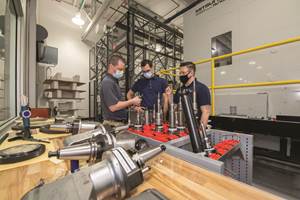Composites Keep A Big Machine Busy
On-machine inspection is part of the way this shop machines large composite structures efficiently.
“The thing to understand about machining composites is that you only get one shot,” says Jeffrey LeDuc, general manager of Reno Machine Company in Newington, Connecticut. Unlike a metal part, there is little or no possibility of repairing a part made from a composite material such as CFRP (carbon fiber reinforced plastic) if it is machined incorrectly. Adding to the pressure is the fact that a CFRP structure is considerably more expensive than a comparable metal workpiece by the time the part gets to the machine tool. Any crash or misstep during machining would not only scrap the part, but also would result in considerable lost expense.
Partly because the size of its machines, Reno is in a class apart from other machine shops in its region. The shop has an established history of working closely with area manufacturers relying on large composite parts. Most of this work relates to helicopter manufacturing, and most of that work has involved machining metal to make both the layup tooling and the machining fixtures for composites manufacturing. Recently, however, customers have been turning to Reno for machining of the composite structures as well. Now, of the two five-axis Henri Liné machines with 35 feet of X-axis travel in this shop, one of those machines is booked for a solid year with just composites machining work.
Because of all the activity, a particular part on one of these machines is now likely to get just one shot in another way, as well. That is, all of the machining for a particular part may need to be performed in just one rapid stop at the machine tool, before the tight schedule requires the next part in line to get its turn.
However, many of these parts include demanding machining tolerances that may need to be verified multiple times. Because of the value of the part, a critical milled feature is likely to be machined conservatively, then inspected to see how much stock remains to be removed, then inspected again after the finish pass.
Reno does not have a CMM big enough to perform this inspection for its largest composite parts. Even if it did, the shop would not want to spend time on transporting the large parts to and from the busy Liné machine. Instead, Reno uses the machine tool itself as a CMM, thanks to an “On Machine Verification” version of Delcam’s PowerInspect software.
When this software is coupled to the five-axis machine as it employs a spindle-mounted inspection probe, Mr. LeDuc says the software can generate inspection reports that are every bit as thorough as those of a CMM. To confirm that the machine tool can indeed inspect parts accurately, smaller parts are often verified with a CMM. The inspection software makes the five-axis machine tool dramatically more effective for machining high-value, tight-tolerance parts, Mr. LeDuc says.
One particularly critical part provides an illustration of the close working relationship between the shop and its main composites machining customer. A CFRP cuff that connects a helicopter’s main rotor blade to the center hub is sent to Reno two different times for machining. The shop does initial machining of features including a bore that receives a metal bushing. The customer inserts this bushing. Then, the part goes back to Reno to machine features that have to locate with respect to the bushing’s position. In other words, on this part, there are actually two different moments when the shop gets just one shot.
Related Content
6 Machine Shop Essentials to Stay Competitive
If you want to streamline production and be competitive in the industry, you will need far more than a standard three-axis CNC mill or two-axis CNC lathe and a few measuring tools.
Read MoreDigital Twins Give CNC Machining a Head Start
Model-based manufacturing and the digital thread enable Sikorsky to reduce lead times by machining helicopter components before designs are finalized.
Read MoreFearless Five-Axis Programming Fosters Shop Growth
Reinvestment in automation has spurred KCS Advanced Machining Service’s growth from prototyping to low-and mid-volume parts. The key to its success? A young staff of talented programmers.
Read MoreWhich Approach to Automation Fits Your CNC Machine Tool?
Choosing the right automation to pair with a CNC machine tool cell means weighing various factors, as this fabrication business has learned well.
Read MoreRead Next
The Cut Scene: The Finer Details of Large-Format Machining
Small details and features can have an outsized impact on large parts, such as Barbco’s collapsible utility drill head.
Read More3 Mistakes That Cause CNC Programs to Fail
Despite enhancements to manufacturing technology, there are still issues today that can cause programs to fail. These failures can cause lost time, scrapped parts, damaged machines and even injured operators.
Read More
.jpg;width=70;height=70;mode=crop)

















.png;maxWidth=300;quality=90)







